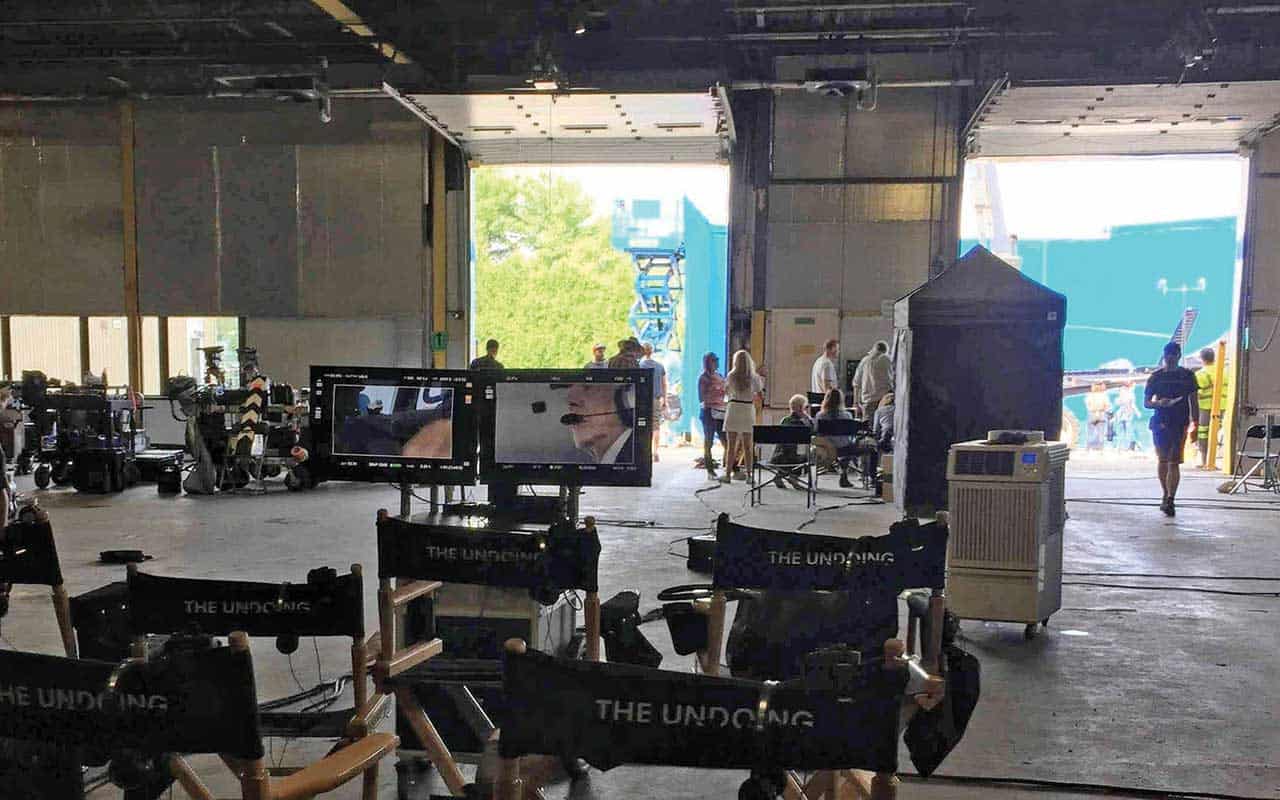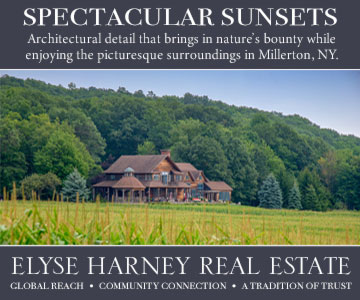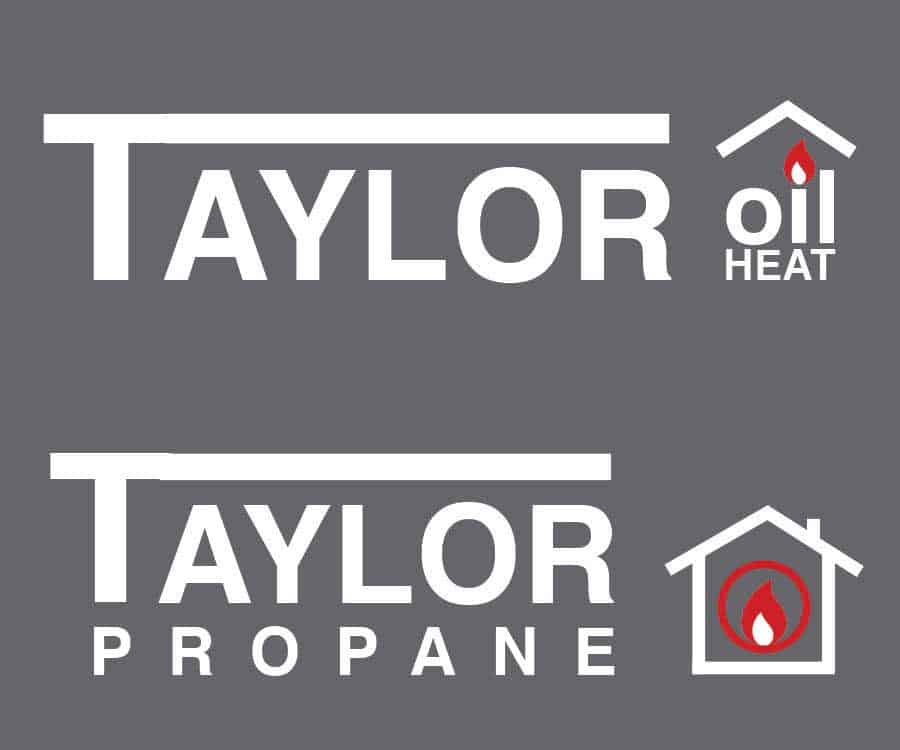Real Estate

Location. Location.
Location shooting, finding and transforming actual sites, as opposed to sound stage filming, has fascinated me since the day a location scout knocked on our door in Greenwich Village. For this article about using your real estate to generate extra income or a higher price when you plan to sell, I decided to update my personal urban experience by talking to people who have had a recent shoot on their property, locations scouts, and, especially, Laurent Rejto of The Hudson Valley Film Commission.
What do location scouts look for?
Location scouts search for the real estate that the director, the art director, and the producer need to make their films and/or TV show or commercial. This can be a parking lot to store equipment, a church basement to set up a kitchen to feed the crew, an orchard, a riding ring, a quarry, a Main Street, or a farmhouse. Ideally locations for a particular shoot are within easy distance of one another like the Stissing House parking lot, the Hammertown guesthouse, and the Presbyterian Church for shooting Hallmark’s Christmas Camp at the Inn at Pine Plains, NY.
Laurent Rejto of the Hudson Valley Film Commission, works closely with location scouts and claims that almost any location can be found in the Hudson Valley from desert scenes shot in quarries to castles to Kentucky – ocean beaches and skyscrapers excepted.
The film and location business is also driven by individual state incentives for feature films and TV series. At the moment New York State is attractive because it refunds 25% of the “below the line” film costs – basically the expense of the locations, the camera crew, props, locations and sets, and post-production activities such as editing, sound and visual effects, etc. If the film’s budget is over $500,000 and filmed in Dutchess County or Columbia County another 10% is added on for qualified labor. Furthermore, the promise of this payment is often used to attract investors to the project. Up to $450 million has been set aside to stimulate film production in New York and to create and maintain film industry employment.
For high budget films, which have hundreds of crew members, large hotel accommodations nearby are desirable. Large hotels in Kingston and Poughkeepsie make the western side of Dutchess and Columbia County more convenient than more rural areas east of the Taconic. The recent I Know This Much to Be True with Mark Ruffalo booked a block of 30,000 nights in area hotels. It has been estimated that in 2019 the film and television industry generated more than $46 million for our region’s economy.
Step one
A location scout may knock on your door because filming is planned in your neighborhood or the scout is aware that your property may fit the vision of the director. It’s always a good idea to ask for identification before you let a scout into your home.
If your location seems promising, the scout will probably take some preliminary photographs with your permission. Good photographs of your property can also be sent directly to www.hudsonvalleyfilmcommission.com with a request that your site be added as a possible location. You can also follow filming work in the Hudson Valley on their website. Last time I talked to them, scouts were looking for eighteenth century log cabins, which had turned out to be surprisingly difficult to find. The site posted a need for an abandoned gas station and found one in Hopewell Junction in just one day.
After initial interest, expect a follow-up visit from the director, the AD (Assistant Director), the Production Designer, and sometimes even the producer. Dick Wolfe, the Law & Orderproducer, visited our house before deciding to use it as the primary location for a TV pilot. He thought it was exactly where a NYC Assistant District Attorney would live. The production company for the 2020 Things Heard and Seen, a Netflix horror thriller movie, left a pamphlet in the mailbox of the new owners of a house and barn on Skunks Misery Road in the Town of North East, NY, explaining their interest in finding locations in the area. Planning to renovate anyway, the owners invited the scout to take a look. Before the shoot some interiors were modified and the faded name of a fictitious dairy added to the barn.
Think before you sign up
If your property is selected you will be presented with a contract from the film production company to sign with a stipulated fee, dates, insurance, etc. Note that they pay the location scout, not you. This contract will be very favorable to the film production company and not very protective of your interests.
Everything is negotiable and should be carefully defined. What are the hours of shooting? What will you get paid for the set-up days before filming and the wrap days afterwards? Exactly where is the crew permitted to be? Who pays for electricity usage? Do you charge a cleaning fee, an overtime fee? Is the liability insurance sufficient and does it cover subcontractors? Will you be paid for damage to your property? How will they protect your floors? Will they repaint your walls? Where will the generator and production trucks park? Can you eat at the “honey” truck or where ever the crew is fed?
Before you decide to participate in a film shoot consider your whole family whose lives will be disrupted. It might be a good idea for small children and pets to consider a visit to the grandparents. You should also consider your neighbors and the possible inconvenience to them. They should be forewarned.
Fees for locations vary hugely and depend on the budget for locations. It could be $1,000 for use of a parking lot or $10,000 a day for a historic home. Smaller, Indy film companies pay less, and student film projects often have no budget. There’s no set rate and owners usually feel that the money makes it worthwhile combined with the excitement. You may also want to determine the content of the film and consider whether it would potentially affect the value of your property. You might not want a mass murder filmed in your barn.
Prepare for an invasion
Before the day comes, take a photo inventory of your property and assign values to objects that will be included in the shoot or moved by the crew. Special Victims Unit dropped a camera on our dining table and broke the slate top. Initially they refused to pay the inventory price, but eventually relented when they couldn’t find a less expensive replacement.
You should make plans to be in the vicinity of the shoot or have a representative on site to make certain that contractual requirements are being met. If they go into overtime someone needs to be there to document the hours. Movie and TV crews are large. There might be 500 to a 1,000 people at a Mission Impossible shoot, but the 40 that were at The Inn in Pine Plains are more typical for our area. They will occupy your property like an invading army. You have to enforce the rules established in your contract like no smoking, no food or open drink cups, etc. And remember to do a walk-through with the location scout at the end of each day. Noisy appliances can be turned off and you might want to turn the refrigerator back on for the night.
It may be Christmas in April or you may get a new silo
The Inn at Pine Plains was transformed with Christmas decorations and snow in April for the Christmas Camp shoot, which lasted two weeks. Patty Vincent, the innkeeper, described it as “quite the experience.
I don’t think I would do it again but I don’t have any complaints. There were 40 of them and they worked 14-hour days. They took away my houseplants and put up Christmas trees.” Vincent even helped the production by connecting them to the Hammertown Barn for a scene and finding them a wishing well. The shoot lasted ten days and on Fridays the crew was gone by 6pm so weekend guests could check in. The snow and Christmas lights delighted them in April.
A Quiet Place, released in 2018, altered equestrian Mistover Farm in Pawling, NY, which is now for sale for $3,750,000, including the New York State qualified production facility that was built at the expense of the production company. The film created a stage in the horse arena and offices inside the stable. The crew also added a silo because the existing silo wasn’t facing the right way and doubled the size of the barn. In addition they found local farmers to raise 100 acres of corn needed for the movie.
Wing Castle in Millbrook, NY, required very little transformation for its role in A Fairy Tale After All, which completed shooting in December 2019. To get an idea of what a location shoot is like at a castle go to https://www.youtube.com/watch?v=xF9F9VmDs8c.
Cash and other benefits
In addition to quick cash, a location shoot can add value to your real estate. All sites are tested for environmental hazards, asbestos, mold, etc., and typically remediated at no cost to the owner. Or maybe your house needs a new coat of paint. Union scenic painters are skilled artisans and do excellent work. Locations work is work for the owner, but there is the satisfaction of seeing your property transformed on the big screen or streaming for your viewing pleasure.
Kevin Walsh’s father Joseph owned the house at 47 Delafield Street in Poughkeepsie, NY, featured in I Know This Much Is True. Watching it on the screen was “indeed a unique experience.” Freshly painted and renovated the house is now for sale. “For us it was a wonderful experience. It was the experience of a lifetime, something I’ll probably never do again.”

Christine Bates is a registered real estate agent in New York and Connecticut with William Pitt Sotheby’s and has written monthly for Main Street Magazine since it’s first issue.





